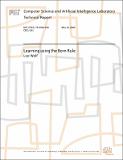| dc.contributor.advisor | Tomaso Poggio | |
| dc.contributor.author | Wolf, Lior | |
| dc.contributor.other | Vision | |
| dc.date.accessioned | 2006-05-16T22:16:59Z | |
| dc.date.available | 2006-05-16T22:16:59Z | |
| dc.date.issued | 2006-05-16 | |
| dc.identifier.other | MIT-CSAIL-TR-2006-036 | |
| dc.identifier.other | CBCL-261 | |
| dc.identifier.uri | http://hdl.handle.net/1721.1/32978 | |
| dc.description.abstract | In Quantum Mechanics the transition from a deterministic descriptionto a probabilistic one is done using a simple rule termed the Bornrule. This rule states that the probability of an outcome ($a$)given a state ($\Psi$) is the square of their inner products($(a^\top\Psi)^2$).In this paper, we unravel a new probabilistic justification forpopular algebraic algorithms, based on the Born rule. Thesealgorithms include two-class and multiple-class spectral clustering,and algorithms based on Euclidean distances. | |
| dc.format.extent | 28 p. | |
| dc.format.extent | 650559 bytes | |
| dc.format.extent | 1572192 bytes | |
| dc.format.mimetype | application/pdf | |
| dc.format.mimetype | application/postscript | |
| dc.language.iso | en_US | |
| dc.relation.ispartofseries | Massachusetts Institute of Technology Computer Science and Artificial Intelligence Laboratory | |
| dc.title | Learning using the Born Rule | |
